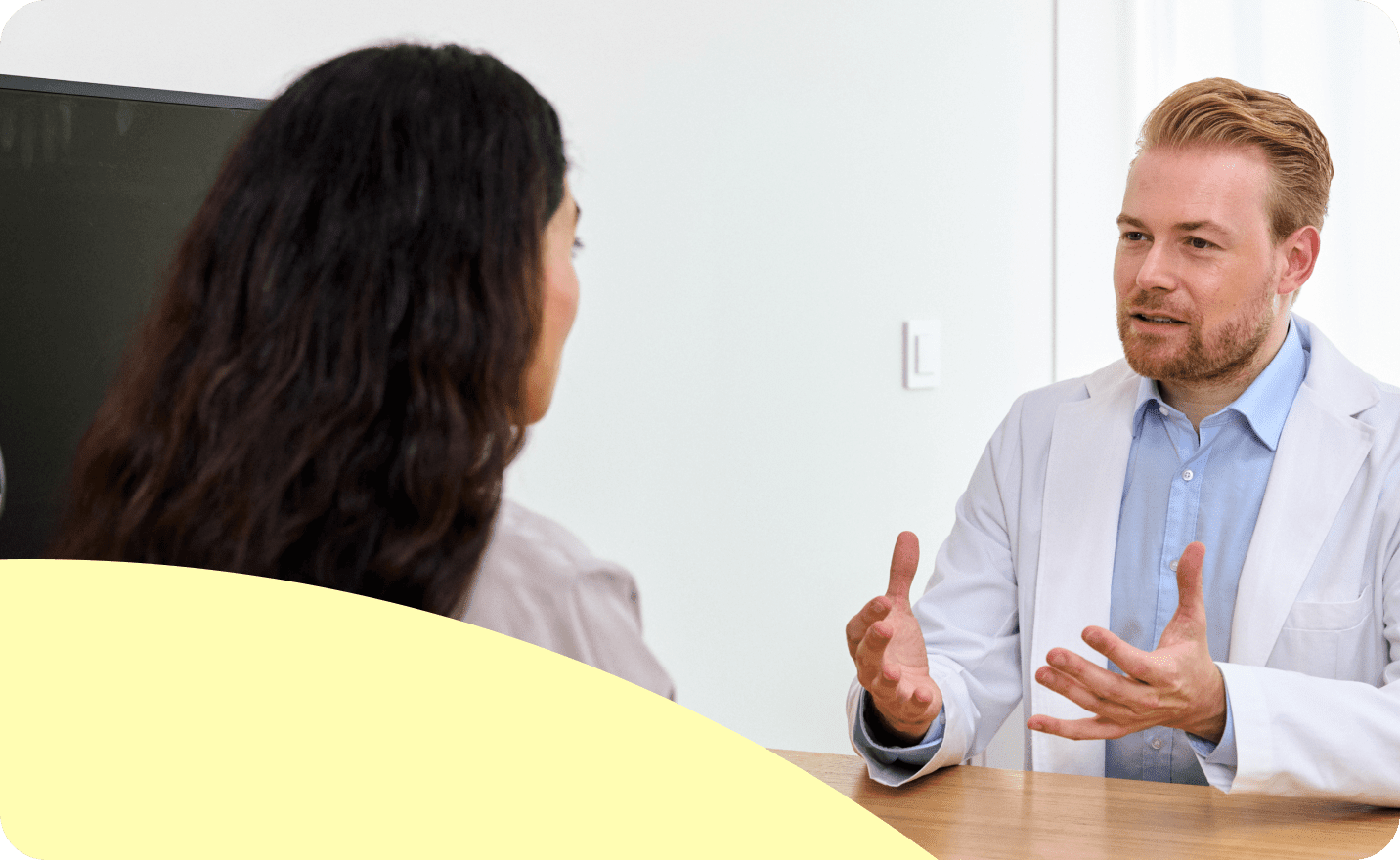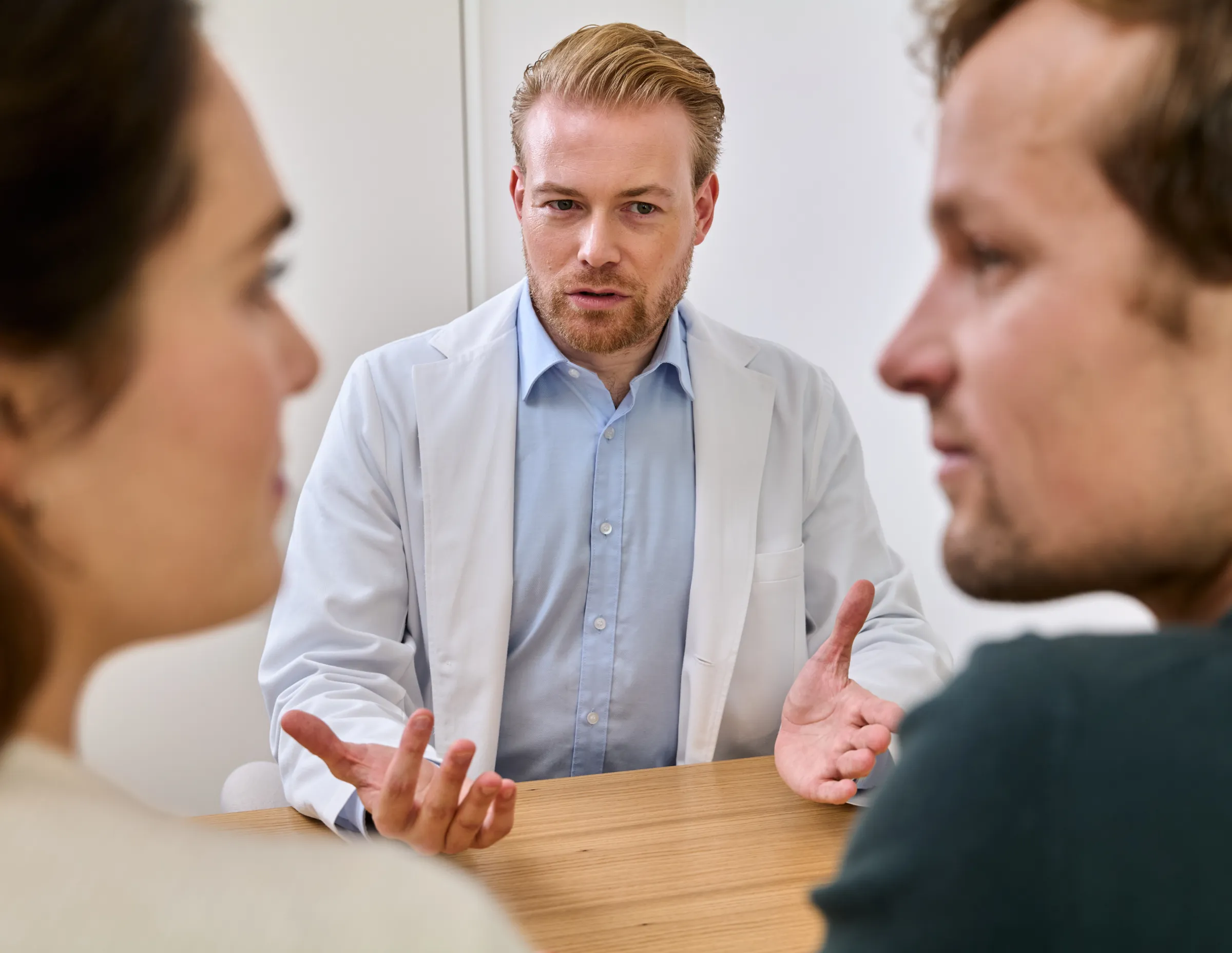Everything you need to know about conception. What is necessary for sperm and egg to meet at the right moment? What are the conditions for successful implantation? And what can disrupt these processes?
The beginning of new life is one of the most fascinating biological processes there is. The successful fertilisation of a mature female egg and its implantation in the uterine lining (also known as the endometrium) play a decisive role.
In this article, we look at how the sperm and egg come together and the complex processes that take place in a woman's body when pregnancy begins. What must occur for the mature egg to meet the sperm at the right moment and be fertilised? What conditions are needed for successful implantation? And what can prevent these processes? Below, we have summarised everything you need to know.
What happens during fertilisation of the egg?
Fertilisation of the mature egg cell (ovum) by the male sperm cell normally occurs in one of the fallopian tubes. After ejaculation, the sperm swim through the cervix into the fallopian tube. When a sperm reaches the egg, it can dock to the cell membrane of the egg and penetrate the outermost layer of the cell. While more than one sperm can dock on the outer membrane of the egg, only one can penetrate and fertilise the egg.
If a sperm has successfully penetrated, the two cells can fuse with each other. Both cells detach from their shells and then form a new cell, with 23 chromosomes from the mother and 23 from the father. The new cell (called a zygote) consists of 46 chromosomes in total. This means that the fertilised egg cell now contains the genetic information of the mother and father. Depending on whether the fertilising sperm carries an X or a Y chromosome, the newly-formed zygote will be either female or male.
When can fertilisation occur?
To understand when fertilisation can occur, we look at the female menstrual cycle. The cycle begins on the first day of menstruation and ends the day before the next menstruation. An average cycle lasts 28 days, but cycle length can vary from woman to woman, or month to month. Cycles between 21 and 35 days are considered normal. If your cycle is not within this range, it may be a good idea to consult with your doctor or a fertility specialist.
The female ovarian cycle includes four phases:
- Menstrual phase: the uterine lining (endometrium) is secreted with menstruation.
- Follicular phase: follicle-stimulating hormone (FSH) is produced and promotes the maturation of the egg. A surge in luteinising hormone (LH) triggers the start of ovulation, which is the release of a mature egg.
- Ovulatory phase: a 12-24 hour time period where the mature egg travels from the ovaries to one of the fallopian tubes.
- Luteal phase: hormones that prepare the body for pregnancy are produced and the uterine lining is prepared for the fertilised egg to implant.
During ovulation, the mature egg enters the fallopian tube where it can meet the male sperm. Even if you do not have sexual intercourse during the 12-24 hour ovulatory phase, there is possibility that the egg can be fertilised. This is because although an egg survives in the fallopian tube for only 24 hours, sperm can survive for up to five days in the female reproductive tract. Therefore, there is a fertile window of six days (five days before ovulation and the day of ovulation itself).
Several methods are available to help you determine your fertile window: apps that track the menstrual cycle, taking your temperature, examining the cervical mucus, and using ovulation tests.
What happens during implantation of the fertilised egg?
At the time of implantation, the fertilised egg embeds itself in the wall of the uterus and attaches to the endometrial tissue. This process is complex and is influenced by a variety of factors. Implantation in the uterus can only occur during a limited period time called the implantation window. Research has shown that the implementation window may vary, but it is typically said to occur 6–10 days after ovulation, lasting between 3–6 days.
The process of implantation unfolds as follows:
The fertilised egg travels to the uterus. The fertilised egg makes its way through the fallopian tubes into the uterus. Around one week after fertilisation, the egg will reach the fallopian tubes.
From the time of fertilisation, cell division begins. The identical cells produced are called blastomeres. Once there are 16 blastomeres, they form a sphere of cells called a morula. The term 'morula' means mulberry in Latin, which is what the cell cluster looks like at this stage. Later, it transitions into the blastocyst and the blastocyst stage begins. This consists of an outer layer of cells, which later becomes the placenta, and an inner layer of cells, from which the embryo develops.
The fertilised egg attaches to the endometrium. When the blastocyst finally reaches the uterus, it attaches to the uterine wall and enters into a dialogue with the endometrium. At this time, various hormones and enzymes are released that enable the blastocyst to penetrate the mucosa (a soft mucous membrane that lines the uterus).
The fertilised egg embeds in the endometrium. The blastocyst finds its place for implantation and embeds itself in the endometrium. It covers itself completely with the uterine lining and connects to the female bloodstream. Thus, it has successfully nested and the body receives the information that it is now pregnant.
Following implantation, the body begins to produce more of the pregnancy hormones hCG (human chorionic gonadotropin) and progesterone. These hormones signal that the uterus is occupied, meaning that ovulation and menstruation will no longer take place. They also ensure that the uterine lining continues to be maintained and the embryo is supplied with a constant blood flow.
Symptoms of implantation
Some women feel little or nothing from the process of implantation. Others, however, are very aware of the change in their bodies. Possible signs of implantation may include the following:
- Implantation bleeding: Often referred to as ‘spotting’, this light bleeding is usually harmless and disappears after a short time. It can occur when endometrial tissue is disrupted during the process of implantation.
- Implantation pain: When the egg implants into the lining of the uterus, you may experience mild abdominal cramping, similar to menstrual cramps. This is commonly referred to as implantation cramps.
If implantation takes place, you may experience some of the following early pregnancy symptoms:
- Tender breasts.
- Nausea
- Fatigue
- Headaches
- Altered sense of smell and taste
- Discharge (cervical mucus)
- Mood swings
- Frequent urination
- Abdominal bloating, constipation, and flatulence
If you experience these symptoms, you may be in the very early pregnancy stages. It may also be that you are experiencing premenstrual syndrome (PMS), as many of these symptoms overlap.
While you may want to take a pregnancy test right away, it is highly suggested to wait until two weeks after ovulation to take a pregnancy test. This is because hCG, the hormone detected in home pregnancy tests and blood tests at fertility clinics, takes some time to build up after implantation. By waiting two weeks, you have the best chance of avoiding a false negative or false positive pregnancy test result.
What can prevent fertilisation?
There are a number of factors that can prevent fertilisation; these may involve the male or female partner, or both. Some of the most common causes for fertilisation not happening are
- Hormonal imbalances: Disturbed hormonal balance, such as in polycystic ovary syndrome (PCOS), can interfere with fertilisation. PCOS causes irregular periods and increased testosterone levels, which can make ovulation and conception difficult. Hormonal imbalance in men can also lead to sperm production disorders.
- Poor sperm quality: Low sperm count or low sperm quality can reduce the chances of successful fertilisation.
- Blocked fallopian tubes: The fallopian tubes may be blocked, for example, due to adhesions after inflammation or adhesions, and therefore the sperm cannot reach the egg.
- Age: Age can also be a factor that makes conception difficult. Women 35 and older tend to have fewer eggs, and egg quality decreases with age. The same is true for sperm quality.
- Stress: Stress can affect hormones in both women and men, making successful fertilisation more difficult.
- Lifestyle: Smoking, alcohol consumption, obesity and other unhealthy lifestyle habits can also have a negative impact on fertilisation.
What can prevent implantation of the fertilised egg?
Unfortunately, even after successful fertilisation, implantation may still not happen. Below are some causes that can complicate or prevent it:
- Problems in the development of the embryo: It can happen that the female body recognises when an embryo is not viable and ends the pregnancy. For example, if there is a disorder of the chromosomes, it usually does not implant or may later result in a miscarriage).
- Hormonal disorders: These can make it difficult for the fertilised egg to implant, for example, by making the uterine lining thin or uneven. An inadequate uterine lining may prevent the egg from finding a suitable place to implant.
- Infections: Infections of the lining of the uterus or cervix can interfere with implantation of the fertilised egg.
- Ectopic pregnancy: this type of pregnancy is a rare complication in which the fertilised egg implants in the fallopian tube instead of the uterus. This can lead to dangerous complications because the fallopian tube does not provide enough space and nutrients for the embryo to develop.
- Uterine malformations: Some women are born with uterine malformations that can interfere with implantation of the fertilised egg. These malformations may cause the uterus to be unevenly shaped or there may be a partition in the uterus that makes implantation difficult.
- Immunologic factors: In some cases, the woman's immune system may prevent implantation of the fertilised egg. The immune system recognizes the embryo as a foreign object and attacks it before it has successfully implanted.
There are many different factors that can make fertilisation or implantation difficult. When couples or individuals remain involuntarily childless for a long period of time, it is a good idea to make an appointment with a doctor or fertility specialist. There are many reproductive medical treatments that can help increase the chances of successful conception, such as hormone therapies, intrauterine insemination (IUI) and in vitro fertilisation (IVF).
How can I promote fertilisation and implantation?
Fertilisation of the female egg and subsequent implantation in the uterus are complex biological processes that depend on many factors. There is no special trick to influence them. However, there are things you can do to keep your body healthy and prepare it for pregnancy:
- Eat a well-balanced diet. A healthy and balanced diet can help improve fertility. Supplements with folic acid can also be taken.
- Regularly exercise. This can help reduce stress and regulate body weight, both of which are important factors in fertility.
- Manage your stress. Stress can affect fertility, so it is important to find methods to manage stress. These include relaxation exercises such as yoga or meditation.
- Avoid smoking, alcohol and other addictive substances. These can affect fertility and should be avoided.
- Have sex at the right time. The best time to have sex is around ovulation if you are trying to get pregnant. You can determine your fertile window with an ovulation test or the temperature method, for example.
- Maintain a healthy lifestyle. A healthy lifestyle and protecting yourself from harmful environmental factors can also positively influence fertility. This can include, for example, getting enough sleep or avoiding harmful substances, such as chemicals.
Takeaway
The process of conceiving a baby is highly complex. In order for fertilisation to occur, the female must ovulate a mature egg and the male must be able to ejaculate sperm that can travel down the female reproductive tract and penetrate the egg. Once the egg is fertilised, it can implant in the lining of the uterus, where it develops into an embryo and eventually a baby. A number of factors, such as proper timing of intercourse and partner fertility, are prerequisites for pregnancy to occur.
Unfortunately, the egg may have difficulty being fertilised or implanting due to a variety of causes. The reasons for this can be varied; for example, hormonal disorders, blocked fallopian tubes or infections can be responsible. If you are still involuntarily childless after a long period of trying, it may be a good idea to see a fertility specialist. There are many ways to get help and support for family planning.
Would you like support on your way to pregnancy? The Cada team is happy to guide you on your journey. Reserve your spot for a personalised consultation today.







